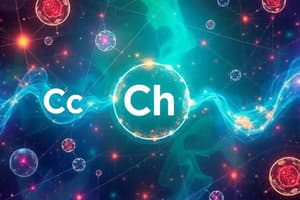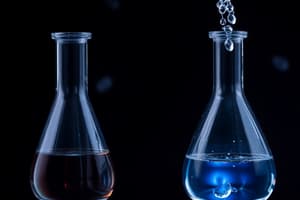Podcast
Questions and Answers
Which of the following statements accurately describes the molecular behavior in solids?
Which of the following statements accurately describes the molecular behavior in solids?
- Molecules are able to overcome their rigid shape.
- Molecules have minimal kinetic energy, restricting their movement to vibrations around fixed positions. (correct)
- Molecules possess high kinetic energy, allowing them to move freely and change positions.
- Molecules move until the liquid reaches a point where surface tension can no longer hold the molecules down.
Which of the following best explains why gases are compressible?
Which of the following best explains why gases are compressible?
- The molecules in a gas are spread out, leaving space between them that allows them to be compressed. (correct)
- The molecules in a gas are closely packed together making it easier to compress them.
- The molecules in a gas have a definite shape and volume, allowing them to be compressed into a smaller space.
- The molecules in a gas possess high surface tension, which allows for compression.
What is the primary difference between a mixture and a compound, as described in the text?
What is the primary difference between a mixture and a compound, as described in the text?
- Mixtures and compounds involve chemical combinations but differ in the energy released during the process.
- Mixtures have a fixed ratio of ingredients that combine chemically, while compounds have varying ratios and do not combine.
- Mixtures do not combine chemically while compounds do. (correct)
- Mixtures are always homogeneous, whereas compounds can be either homogeneous or heterogeneous.
Why are liquids and gases both classified as fluids?
Why are liquids and gases both classified as fluids?
What happens when heat energy is added to a solid matter?
What happens when heat energy is added to a solid matter?
What is the primary distinction between isotopes of the same element?
What is the primary distinction between isotopes of the same element?
Which fundamental interaction is primarily responsible for holding the nucleus of an atom together?
Which fundamental interaction is primarily responsible for holding the nucleus of an atom together?
What happens to an atom when it gains an electron?
What happens to an atom when it gains an electron?
What is the maximum number of electrons possible in the third shell (n=3) of an atom?
What is the maximum number of electrons possible in the third shell (n=3) of an atom?
Which of the following best describes a compound?
Which of the following best describes a compound?
Which statement accurately describes the concept of matter?
Which statement accurately describes the concept of matter?
What is the fundamental process that occurs when atoms bond together to form molecules?
What is the fundamental process that occurs when atoms bond together to form molecules?
Pure copper is considered an element because it is comprised of which of the following?
Pure copper is considered an element because it is comprised of which of the following?
Flashcards
Mixtures
Mixtures
Combination of ingredients that do not chemically bond.
Kinetic Energy
Kinetic Energy
Energy of motion that affects the physical state of matter.
Solid
Solid
Matter with a definite shape and volume, incompressible.
Liquid
Liquid
Signup and view all the flashcards
Gas
Gas
Signup and view all the flashcards
Matter
Matter
Signup and view all the flashcards
Atoms
Atoms
Signup and view all the flashcards
Ions
Ions
Signup and view all the flashcards
Isotopes
Isotopes
Signup and view all the flashcards
Compounds
Compounds
Signup and view all the flashcards
Chemical bonding
Chemical bonding
Signup and view all the flashcards
Energy levels
Energy levels
Signup and view all the flashcards
Study Notes
Matter
- Matter occupies space and has mass, existing in solid, liquid, or gaseous forms.
- Matter is composed of small particles called atoms.
- Atoms are mostly empty space with a dense nucleus containing protons and neutrons, surrounded by electrons in shells representing energy levels.
- Four fundamental interactions within atoms: gravity (insignificant at atomic scale), weak nuclear, electromagnetic, and strong nuclear.
- Electromagnetic interaction acts between the nucleus and electrons; it's responsible for electrical and magnetic energy.
- Strong nuclear interaction holds the nucleus together.
- Pure copper is an element comprised solely of copper atoms (Cu).
- An atom is the smallest part of an element retaining the element's properties.
- Maximum number of possible electrons in a shell: 2n2 , where n is the shell number.
- Each atom has a unique atomic number (number of protons) and atomic mass.
- Ions are atoms that have gained or lost electrons. Gaining electrons creates a negative ion; losing electrons creates a positive ion.
Isotopes
- Isotopes are atoms of the same element with different numbers of neutrons.
- Atomic number remains the same; atomic mass changes.
Compounds
- Compounds are substances formed when multiple elements combine in specific proportions to create new substances.
- Chemical bonding involves sharing or transferring electrons to form molecules.
- Compounds are matter where all molecules are identical but consist of different atoms in set proportions.
Mixtures
- Mixtures are combinations of two or more substances where each keeps its individual characteristics.
- Components in mixtures do not chemically combine.
- Mixtures have variable ratios of ingredients.
States of Matter
- Matter exists in three primary states: solid, liquid, and gas.
- Solids have fixed volume and shape; molecules do not move far from their relative positions.
- Liquids have fixed volume but conform to the container shape; molecules can move more freely.
- Gases have neither fixed volume nor shape; molecules move freely within a container.
Solids
- Solids have a definite, fixed shape and volume.
- Solids are incompressible.
- The molecules or atoms within a solid have little heat energy and are fixed in position.
Liquids
- Liquids maintain a fixed volume, but they conform to the shape of their container.
- Liquids are incompressible.
- Increased heat energy causes increased molecular movement, allowing liquids to flow.
Gases
- Gases have neither fixed volume nor shape; they take the shape of their container.
- Gases are compressible, as molecules are spread out.
- Increased heat energy leads to rapid molecular movement and eventual gas or vapor formation.
Studying That Suits You
Use AI to generate personalized quizzes and flashcards to suit your learning preferences.




